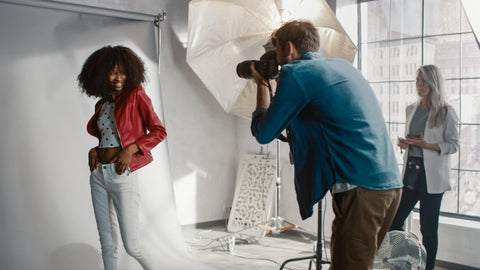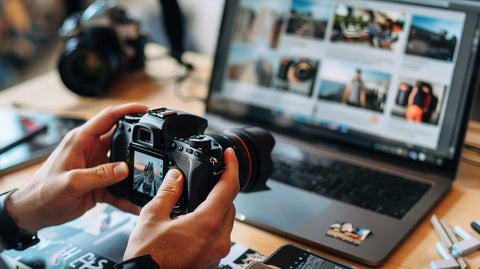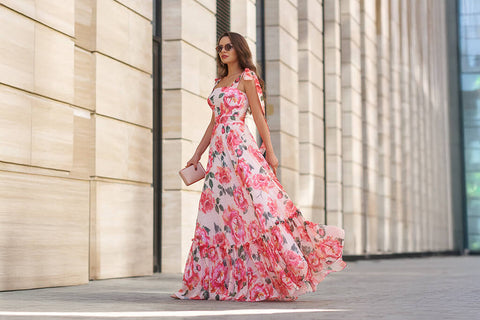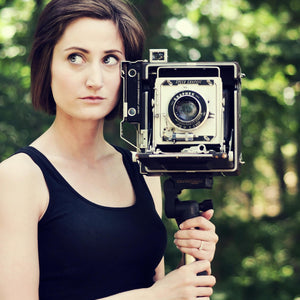- Lightroom Presets
- Mobile Presets
-
Photoshop
-
Learn
-
Support
-
Install
- Best Sellers
- Blog
By Anna Gay on | No Comments

At some point, you will be introduced to the RAW file format, whether through an online forum or website or face-to-face with your photographer buddies.
Many photographers approach shooting in RAW with fear and trepidation - I see it every day! AND I also remember how confused I was by the concept at first. I wasn't necessarily afraid, but I definitely did not understand what a RAW file was and how it could help me.
In this post, I will unpack the mystery of shooting in RAW, show you how easy it is to shoot in RAW, and how editing RAW files gives you much more flexibility!
This post is not intended to make you think that RAW is the ONLY file format you should use, but it is intended to show you what RAW is, along with some of its positives and potential drawbacks.
In the end, it's up to you whether or not you want to make the switch from JPEG to RAW. What I will tell you, though, is that it is not nearly as complicated as you may think.
After having a discussion in our forum about what everyone finds to be confusing or scary about RAW, the most common reason was this: people have been told early on in their journey that shooting in RAW is complicated and that, since they are new to photography, they should only shoot in JPEG to "keep things simple."
While I agree with that idea on some level, I also feel like it's a very general assumption and quite limiting.
It seems to me that the BEST time to learn to shoot RAW is from the very beginning, BEFORE you get set in your ways - the beginning of your journey is when you should be developing good habits! If you tell a beginner, "As a beginner, you should stay away from XYZ because it's really complicated..." most people will be turned off of the concept and maybe even hesitant to approach it in the future.
Another common reason why people are initially hesitant to shoot RAW is because of storage issues since RAW files are much larger than JPEG. While that is true (I will address this concern in depth later on), the file size should not be a deterrent in this day and age. Storage space has become relatively inexpensive.
For every photographer I have run across that is hesitant to shoot in RAW, I have come across even more who can't imagine shooting any other format. The common thread is always something along the lines of, "I was afraid of shooting RAW at first, but one day I tried it, saw how easy it is to use it and how much more control I have in post-processing!"
I want you to get excited about shooting in RAW, so let's get started and take a look at what RAW is all about.
You know that film photography uses negatives, right? All of the information recorded by the camera is on the piece of film in the camera at the time the photo was made.
In the same way the image information is contained in the negative in film photography, in digital photography, the image information is contained within the RAW file - it is a file that includes all that the camera's sensor "saw" when the image was made, with minimal compression or file manipulation. Just like all the image information is contained in the negative in film photography, in digital photography, all of the image information is contained within the RAW file.
In comparison, the JPEG files that your camera defaults to are highly compressed files, and because of this compression, they lose some of their original file information.
But what is compression?
Compression simply refers to the amount of data contained in a file such as a JPEG or PNG. A JPEG is a highly compressed or "lossy" file format. It does not include the same amount of information as a RAW file, which is considered a "lossless" format.
We'll talk more about what information is compressed below, but for now, simply know that a RAW image file contains MORE INFORMATION than the standard JPEG.
And more information equals more freedom in your post-processing.

Remember, a RAW image file is not truly an image yet - it Is digital information that needs to be converted to a viewable image format. Just like a negative in film photography, the RAW image file is not yet a usable image - it has to be manipulated to create a (traditionally) usable image.
So, instead of having film negatives made into prints to see our images, we are converting a file to a format we can look at on our computers, share online, and/or print.
You may wonder why you can see an image preview on your camera's LCD screen after you take a photo if the RAW file is not viewable.
The answer is this: when shooting in RAW, the image on your camera's LCD screen is a JPEG preview of the RAW image. So, instead of showing you the RAW file (again, you can't actually view the RAW file itself), your camera is taking "certain information" from the RAW file and converting it to a JPEG preview that reflects what was recorded in the RAW image file.
A JPEG image is an image file that can be viewed across devices without the need to be converted to a viewable file format, whereas a RAW file is not yet a universally viewable image file. A RAW file is an electronic bundle of information that needs to be converted to a format such as a JPEG, TIFF, DNG, etc., in order to view and edit it in Photoshop or Lightroom.
After being converted to a DNG (short for "Digital Negative") and imported to Adobe Camera Raw or Lightroom, images shot in RAW appear to have less contrast and are typically not as sharp as a JPEG. They also appear less saturated. All of this is EASILY adjusted in post-processing.
Here is a comparison of a RAW file and a JPEG, both untouched, straight out of the camera:

As you can see, the RAW image has less contrast, clarity, and saturation than the JPEG. This is because the RAW file is not compressed - it is precisely what the camera's sensor "saw," whereas the JPEG is a highly compressed version of the RAW image.
Your camera's software discards certain information in order to compress a file while simultaneously editing the image in-camera to look the way the camera "thinks" it should look. Therefore the compressed JPEG will look slightly different than the RAW file.
There is a common misconception that a RAW file requires much more editing than JPEG.
While RAW does require one or two more steps in your workflow than JPEG, those steps are minimal and not time-consuming. We will get to that in the next section, but the "extra" editing required for a RAW image takes only seconds to perform. And with presets in Lightroom and Adobe Camera RAW, your RAW images may only need one click to adjust contrast, clarity, and saturation.
Since RAW files are not compressed, they are MUCH LARGER than JPEGs and take up more space on your camera's memory card. So you will need a LARGER memory card to shoot in RAW.
So far, we have mainly been comparing the basic differences between RAW and JPEG, so now let's now discuss some of the benefits of RAW over JPEG:
First, and arguably the most important advantage (as previously mentioned), RAW files give you much more control in editing than a JPEG ever will. Since RAW gives you a wider dynamic range, the values ranging from whitest white (highlights) to solid black (shadows), you will have more freedom to adjust exposure without running into pixelation.
For example, if you have an underexposed RAW image, you can increase the exposure much more than you can with a JPEG. A JPEG will give you pixelation and digital noise in the shadows much sooner than a RAW image.
Do you ever find that the color in your photos seems "off" from what you saw with your eyes? While replicating exactly what we see with our eyes is nearly impossible, you can come VERY close when shooting in RAW.
RAW image files can contain anywhere from 4096 - 16384 different colors, whereas a standard, compressed JPEG can only have 256. This also gives you more room to tweak the color of a RAW image in post-processing.
Since a RAW file gives you more freedom with color and dynamic range, correcting the white balance of a RAW file is much easier, fine-tuned, and will give you more natural results than correcting the white balance of a JPEG file.

First, you need to set your camera to shoot in RAW, which is done through your camera's menu. Your camera defaults to shooting in JPEG, so you will need to change your settings when you want to shoot in RAW (or switch back to JPEG). The images below show where to change the file type on a Canon 5d Mark ii and a Nikon D90.
On the Nikon, press the Menu button, navigate to Image Quality, and select NEF (RAW). As you will see below, you can choose to also shoot in RAW + JPEG. When you are new to shooting in RAW, you may want to shoot in both formats until you are confident enough to shoot in RAW alone.
You will also see RAW + JPEG Fine, Normal and Basic, which are varying levels of compressed JPEGs, with Fine being the highest quality (and also the largest of the JPEG file sizes) and Basic being the lowest (and smallest size).
Keep in mind that shooting RAW + JPEG will take up A LOT of space on your memory card, so making a choice early on to shoot in just RAW will save you a lot of space.

Setting up your camera to shoot in RAW on a Canon is similar to Nikon, except the RAW + JPEG option will have L, M, and S for JPEG, which stands for Large, Medium, and Small JPEG files - similar to Fine, Normal and Basic on the Nikon. To shoot only in RAW, make sure that the red box is around RAW and that the straight line is selected in JPEG:

If you still have questions about how to set your camera to shoot in RAW, or if you have a camera model that was not covered here, please refer to your camera's manual.
Next, all you need to do is shoot as you normally would, taking every measure to get your in-camera shot as perfect as possible. The fact that you are shooting in RAW should not affect how you shoot in any way.
Even though RAW gives you much more leeway in your editing, you will still need to strive to get your shot correct in camera. A common misconception about shooting in RAW is that you can use Auto White Balance, and everything will come out great. While this is true - you can use Auto White Balance and easily adjust any incorrect tones in post - getting your white balance right in-camera will save you a step in your editing workflow.
Here is an example of a RAW file shot with the white balance set to Auto and Daylight:

The Auto White Balance image is not too bad, but it is more on the blue side than what the flower and table actually look like. With the white balance set to Daylight, the image looks much more accurate to what the setup looked like in real life. Again, post-processing can quickly fix this, but I encourage you to save yourself a step and get it right in-camera!
The main thing that will change for you when shooting in RAW instead of JPEG is that you will need more storage for your RAW files on your camera's memory card than you would for JPEG files. So, if you are shooting with an 8GB memory card and have a wedding to shoot, you will definitely want a larger memory card, and you should probably purchase more than one.
Once you have finished your shoot and it's time to edit, you will need to import the RAW images into a program on your computer that will convert the image from RAW to a file you can edit, such as DNG. DNG stands for "Digital Negative," playing off the idea of a film negative. This is Adobe's standard RAW conversion format.
In Photoshop, when you open the files, Adobe Camera Raw (ACR) will appear. At this point, you can make adjustments to your image. If you use actions and brushes or textures/overlays, follow the prompts to open the image in Photoshop once you have completed your basic adjustments.
In Lightroom, simply import the images to your Library.
After you have imported the files into your editing program of choice, you will see that the images on your screen look different than they did on your camera's LCD screen. Do not panic; this is how it works, and it's totally normal!
Remember our straight-out-of-the-camera RAW and JPEG comparison earlier? That is exactly what you are seeing here. With Lightroom in particular, when the image is imported, it will suddenly look different. This is because Lightroom is switching from showing you the JPEG preview to the original RAW file. This may sound a bit confusing, but you will know exactly what I mean once you see it happen in Lightroom.
When you have finished editing, you can then export/save it as a TIFF, PSD, JPEG, etc., depending on your client's or your printer's needs. At this point, if you export as a JPEG, you won't lose the edit that you made to the RAW image - in other words, your exported/saved image will look like your final edit, NOT the photo that you originally imported.
Most photographers who shoot in RAW prefer to save/export as a DNG for their records. You may find that your printer requires a JPEG or a TIFF, but for your own records, exporting/saving as a DNG will take up less storage space on your computer than a file such as a TIFF or a RAW file, but it's still considered a relatively lossless file format.

This is a hot question and always up for debate. I understand the arguments for why you should always shoot in RAW, and I also know why some photographers choose to shoot in JPEG. I really do believe that it comes down to personal preference on this issue, though, so I am not going to tell you that there are times when you shouldn't shoot in RAW, nor am I going to tell you that you should always shoot in RAW - that is up to you and what you feel is best for your situation.
Let me give you an example of a situation where you may NOT want to shoot in RAW:
During an impromptu shoot with friends and their children, you only have an 8 GB memory card with you. Since you weren't planning on doing much shooting, you aren't as prepared as you would normally be before a regular, planned shoot with a client.
This is a situation where you could either shoot in RAW and have around 150 images to work with, or you could shoot in JPEG fine (the highest quality JPEG setting) and get around 500 shots.
Anyone with kids knows that erring on the side of 500 shots will give you way better odds than 150! Also, if you have good light and know how to get things right in camera, you probably won't need much editing, so the RAW format is not as important here.
In short, because a) you are in a pinch and only have an 8 GB and b) you have great light where you can nail your shots in-camera, you may want to choose to shoot in JPEG over RAW.
So, with that example in mind, know that there will be SOME SITUATIONS where it will be more practical and more beneficial for you to shoot in JPEG.

I hope this guide encourages you to try shooting in RAW or at least sparks your curiosity!
As you can see, there is nothing to fear when shooting in RAW, which is almost EXACTLY the same as shooting in JPEG. You just have MORE CONTROL IN YOUR EDITING, and what's not to love about that?
If you are still not 100% comfortable shooting in RAW, then ease into it. If you are unsure, I suggest that you DON'T shoot a wedding (or even a full session) the first time you shoot in RAW. Practice around your house and with your friends and family until you get the hang of how it works.

Do you have any questions or comments about the RAW Image Format? Leave us a comment below - we would LOVE to hear from you! And PLEASE SHARE this post using the social sharing buttons (we really appreciate it)!




Anna Gay is a portrait photographer based in Athens, GA and the author of the dPS ebook The Art of Self-Portraiture. She also designs actions and textures for Photoshop. When she is not shooting or writing, she enjoys spending time with her husband, and their two cats, Elphie and Fat Cat.

Comments